
.

.

.

.

.

.

.
 Shop
Shop

This is an Ad. Advertised sites are not endorsement by our Forum. They may be unsafe, untrustworthy, or illegal in your jurisdiction. Advertise Here
 Bidding Open
Bidding Open
This section allows you to view all posts made by this member. Note that you can only see posts made in areas you currently have access to.
Messages - stormgain
Pages: 1 ... 33 34 [35] 36 37 38
511
« on: September 10, 2021, 03:39:08 PM »
ETH and altcoins pull ahead as Bitcoin stagnates
Ether is enjoying a hot streak, breaking above $3,900. That’s just shy of the cryptocurrency’s all-time high in May this year. This comes as the mainnet of Ethereum’s Layer 2 scaling solution, Arbitrum One, opens to the public. Part of the much-anticipated upgrade to Ethereum 2.0, the new scaling model introduced by the London hard fork, aims to lower transaction fees to users all across the network. Other changes brought about by the new EIP-1559 update (Ethereum Improvement Proposal) include reduced ETH token supply. This contributes to driving up the value of each coin. In addition to the upgrades, Ether has been bolstered both by the growth of decentralised finance (DeFi) and NFTs, two crypto-industry sectors that are primarily developed on the Ethereum blockchain.
Meanwhile, Bitcoin continues to trade sideways, attempting a rally and falling just shy of the $50K threshold. The original cryptocurrency has seen a decline in volatility over August, but in the next month, when traders return from their summer holidays, an uptick in activity could soon set the price in motion. In the meantime, ETH and certain altcoins are enjoying their time in the sun.
Is a new all-time high on the horizon?
In May, Ether recorded its last all-time high of $4,372. Now it’s edging towards the $4,000 resistance level once more. Will it breach it and set a new record? Some analysts are enthusiastic about Ethereum, noting how the recent system updates make the ETH cryptocurrency more attractive than ever.
Nick Agar, the founder of cryptocurrency firm AXIA Coin, noted how increased scarcity has increased demand from investors. Agar was quoted in Marketwatch as saying that, “with Ethereum’s recent burn rates resulting in over $561 million burnt away from circulation, a basis has been formed for the increasing accumulation of the token by investors”.
The ‘burn rate’ refers to how the EIP-1559 upgrade changes the Ethereum network’s transaction mechanism. A base fee is charged for every block found on the network, with the remainder being ‘burned’ (as in, deleted), reducing the overall supply of Ether in circulation. At the time of writing, the Ethereum network has burned over $500 million of ETH, a number that continues to climb along with the price increase.
Crypto analytics firm IntoTheBlock noted that several metrics indicate a bullish tendency for ETH. In the company’s Telegram channel, analysts highlighted that the volume of large Ether transactions reached $16.2 billion, the highest since 22 June and that the number of addresses with ETH holdings for over one year is also approaching an all-time high.
Katie Stockton, founder and managing partner of Fairlead Strategies, predicted a promising future for ETH in her Monday notes. She stated that “Long-term momentum is strengthening and trend following measures like the 200-day (~40-week) MA and weekly cloud are rising”.
ETH isn’t the only altcoin enjoying a surge as Bitcoin’s market dominance slumps. Cardano recently doubled in value to become the third-largest coin by market capitalisation, just behind Ethereum and Bitcoin. Avalanche grew even more, tripling over August, while Dogecoin is also enjoying surges in value. It’s the perfect time to think beyond Bitcoin and diversify one’s crypto portfolio.
Trade ETH and other altcoins on StormGain
If you’re ready to profit from Ethereum’s upward surge, StormGain is still the best one-stop crypto platform on the market to buy, sell and hold a great choice of digital assets, including ETH, BTC, Cardano, Avalanche and many more! Thanks to StormGain’s profit-sharing model, users only pay fees on profitable trades and gain some of the best bonuses in the industry through the StormGain loyalty programme. That includes up to 12% APR on crypto holdings, bonus funds and even free BTC via the StormGain cloud miner. Not a StormGain user yet? Register your account in just a few seconds to see the full range of features and try out the user-friendly interface with a demo account!
512
« on: September 09, 2021, 03:26:23 PM »
El Salvador Day and Bitcoin’s Crash
For El Salvador and Bitcoin, 7 September became a day to remember: for the first time in history, a cryptocurrency has been adopted as legal tender. Meanwhile, Bitcoin went through the biggest correction in a single day since the Chinese crypto recession because El Salvador was neither technologically nor mentally ready to accept cryptocurrency. El Salvador’s president Nayib Bukele tried to soften the negativity from the correction by stating that the country was “buying the dip”.
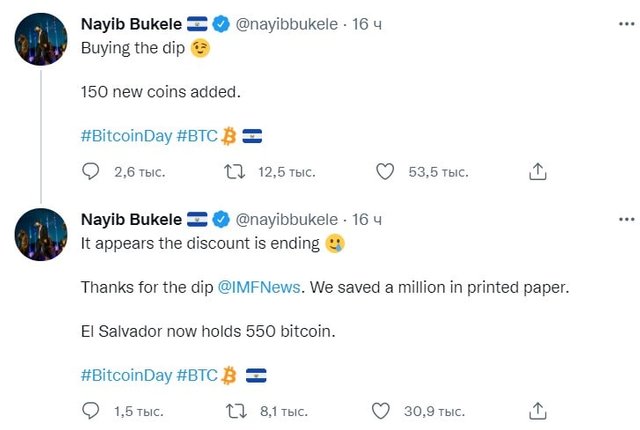
Salvadorians are migrating to other countries in search of work but continue to send money transfers to their relatives. In 2019, they amounted to 20% of the country’s GDP, or $6 billion. The transfers in USD remained critically unprofitable, enriching the banking structures in the United States. For Nayib Bukele, this became one of the main reasons for integrating Bitcoin. Now, the Bitcoin network’s fee constitutes $3 while it costs $18 to send money from Los Angeles via Western Union, $7 via Ria, and $5 via Xoom and Boss.
Per the country’s new law, retailers will have to accept USD as well as BTC as payment. The government will be responsible for paying the conversion costs, for which a $150 million reserve fund has been created. Retailers will be able to choose the legal tender they receive. Apparently, with cryptocurrency’s growing adoption, the government’s expenses will also grow. Meanwhile, high volatility will amplify the problem.
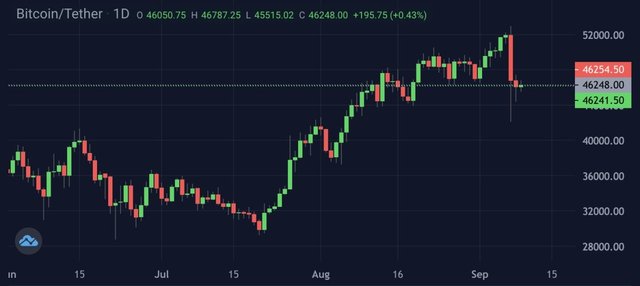
On the day Bitcoin was adopted as legal tender, its volatility exceeded 20%. For retailers, this could signify a loss of profit of a similar amount if they had set the price of goods in BTC. This is why most retailers have preferred to receive fiat funds.
For many Salvadorans, crypto technologies still largely remain unknown territory, and pensioners are afraid that these innovations are directed at taking their USD pensions from them. That’s why there were several protests in El Salvador on the day, with several thousand people rallying in front of the Supreme Court.
Nayib Bukele asked the IMF to help integrate Bitcoin into the financial system, but his request was turned down. Even worse, $1 billion in financial aid that the IMF was considering for El Salvador has been held off for an unknown period. In July, Moody’s credit rating agency lowered El Salvador’s investment rating because of mounting financial risks, which has badly affected demand for its government bonds.
These circumstances are intensifying fears that the government will collapse, the country will fall into crisis and the Bitcoin experiment will flop. All these sentiments caused the cryptocurrency to record the biggest single-day drop since May.
The StormGain Analytical Group
(a platform for trading, exchanging and safeguarding cryptocurrency)
513
« on: September 07, 2021, 12:06:43 PM »
Ethereum putting pressure on Bitcoin
Ethereum is growing more confidently than Bitcoin, and there are objective reasons for this that could send the altcoin to the highest market capitalisation in the long run. We told you about them at the start of this year, and now it’s time to update the data.
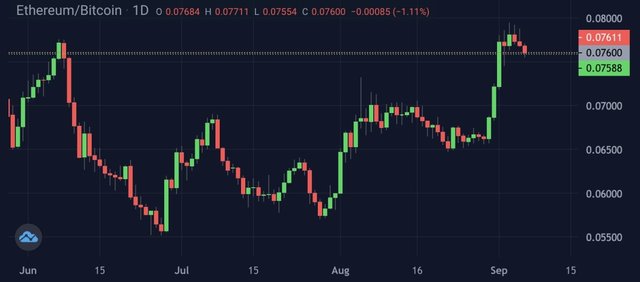
This month, the altcoin has grown twice as much as Bitcoin has, experiencing 50% growth. The main driver has been the London hard fork that took place on 5 August. It introduced a deflationary mechanism resulting in the base fee now simply being burnt, while miners claim tips on top of it. In 29 days, 174,000 ETH, or $565 million, have been burnt.
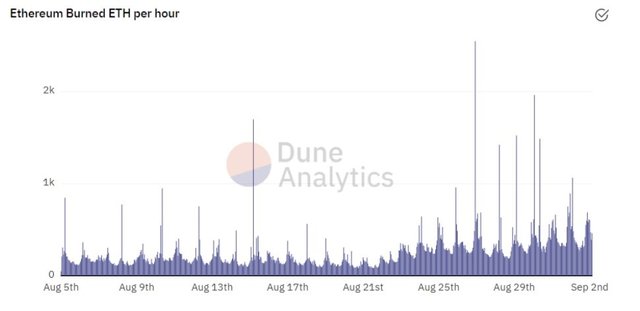
The gap at the 12-month distance has been even more impressive, showing Ethereum go up by 820% versus 350% for Bitcoin. The altcoin owes its popularity to its smart contracts, whose functional capabilities have caused a boom in the DeFi (decentralised finance) and NFT (non-fungible token) markets.
DeFi allows participants to exchange tokens, receive passive income and lend and borrow without intermediaries. The algorithms written into the smart contracts are in charge of executing the operations. The market is so promising that Bank of America and ING Bank are already declaring DeFi a threat to the traditional banking sector, which has grown from $8 billion to $97 billion in 18 months.
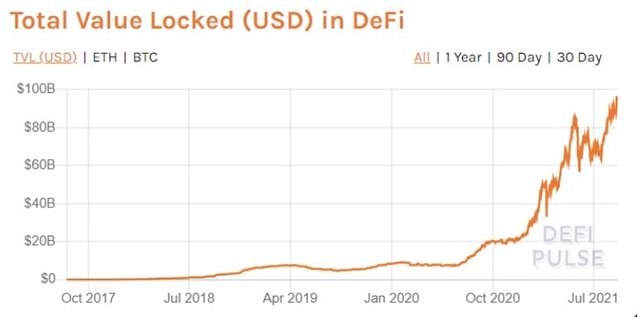
NFTs are unique tokens that are normally used as copyright tags. They are easy to gift, sell or buy. This year, auctions with digital pictures have already been held at such venues as Christie’s and Sotheby’s. The most expensive NFT was purchased for more than $69 million from Mike Winklemann.
The NFT power is in its accessibility and dilution of geographical and legal boundaries. For example, artists from Zimbabwe have been making a living on this technology. Huliodraws sold his latest work, Meme Reunion, for 0.55 ETH. And teenagers can even make pocket money without having a bank account. By way of example, a 12-year-old boy from London received $400,000 from the sale of Weird Whales.

The practicality of smart contracts has led to the Ethereum network seeing more transactions than Bitcoin since 2017, with the discrepancy growing ever since.
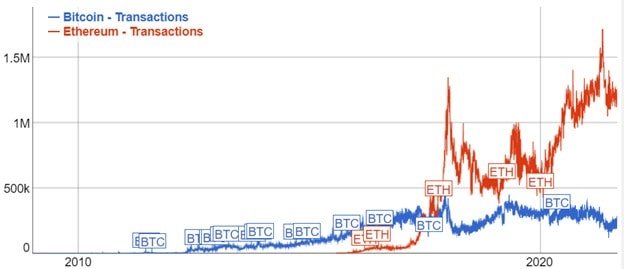
The altcoin can take the leading position in capitalisation after the transition to the proof-of-stake protocol scheduled for 2022. Now, the scalability problems have led to high network workloads, with the average fee once again exceeding $30. Higher fees slow down the adoption of Ethereum and limit its usage.
What do you think about Ethereum’s chances of getting ahead of Bitcoin? Let us know in the comments!
The StormGain Analytical Group
(a platform for trading, exchanging and safeguarding cryptocurrencies)
514
« on: September 03, 2021, 02:38:36 PM »
Hidden Threat: Tether is reluctant to disclose its reserves structure
Tether is the leading bridge currency between fiat money and crypto assets. It boasts a market capitalisation of $66 billion and a daily turnover of $88 billion. The stable operation of crypto exchanges depends on the financial state of affairs at the namesake company because an overwhelming majority of exchanges use Tether as their base currency. According to the company’s initial claims, every USDT is backed by one US dollar. However, audits have proven this claim to be untrue. Now, the company is trying to hide the what things are actually like from the public.
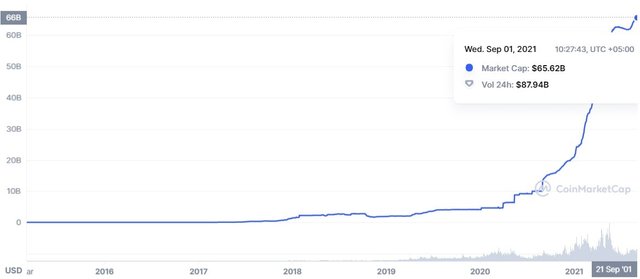
This year, the New York Attorney General’s Office (NYAG) finished its investigation into Tether. As result of a pre-trial settlement, Tether has agreed to pay out $18.5 million and report on its reserves to the authorities regularly (read more about this in our article). After that, it was found that half of the USDT reserves were composed of undisclosed commercial papers, and only less than 4% were held in fiat funds.
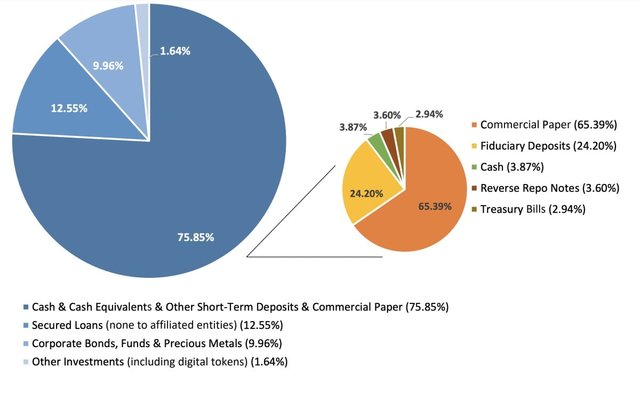
Tether’s fiat reserves exceed its liabilities, but their structure raises a lot of questions. For example, in the event of a crisis, the inability to convert USDT to USD at a 1:1 rate will cause a rapid fall in the stablecoin’s valuation and damage confidence in crypto exchanges. As a result, cryptocurrencies will go through a bigger correction than the one that occurred in May 2021.
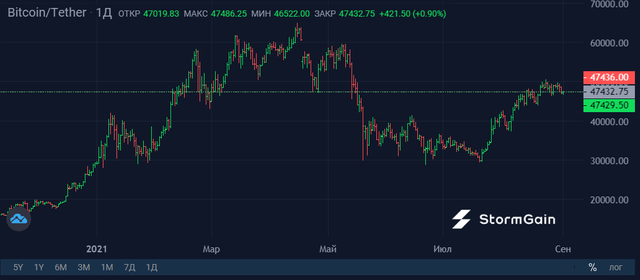
It’s not surprising that the community keeps a close watch on the developments in the Tether case, but the company doesn’t feel comfortable under such scrutiny. On 31 August, representatives from the organisation filed a request to the New York Supreme Court to the NYAG from releasing access to information about the company.
'...we vigorously oppose the notion that proprietary information of our company, or any company in our community, should be made public simply to satisfy Internet trolls or other detractors.'
Now, the disclosure of the details and commercial papers that constitute half of USDT’s backing will depend on the Supreme Court’s decision. If the assets turn out to be of low quality, it will damage confidence in the token and cause a backlash on the cryptocurrency market.
The StormGain Analytical Group
515
« on: September 01, 2021, 11:23:52 AM »
First came electricity, then came blockchain: how to invest in the tech revolution
Nowadays, everybody wants in on cryptocurrency. Thanks to the dramatic price movements of digital coins and the availability of crypto trading apps, people can make huge profit trading crypto. But what is the value of all this digital money beyond speculation?
This is a question that traders should consider, especially when it comes to understanding the differences between cryptocurrencies and how their integration into computer systems and financial systems could affect their value.
According to economics professor Jason Potts, co-director of the Blockchain Innovation Hub at RMIT University, blockchain (the distributed ledger system that all cryptocurrencies are based on) represents a ‘technological revolution’ on the level of the joint-stock company, the internet and even electricity.
In a recent interview with Cointelegraph, Potts highlighted how blockchain technology is even more revolutionary than the internet, which made it possible for communications and coordination for business and social affairs to move at lightning speed and practically zero costs at a previously inconceivable scale. But the actual work of making contracts and managing money is still done by real humans in different companies. Blockchain is what will really complete the digital revolution by fully digitising the economy.
Cryptocurrency has been around for over a decade now, but a revolution takes time, and we’re still in the early days. Electricity, for example, was developed in the 1860s. But it took about 50 years to become fully integrated into the global economy in the 1920s and ‘30s with the advent of the electric motor.
What makes blockchain so important is that it is an institutional, rather than industrial, technology. While blockchain doesn’t manufacture anything, it does provide a new way for people to organise and coordinate. For example, consider charter companies, which were first formed by European kingdoms for empire-building in the 16th century. Nowadays, we take for granted that most products, services, and jobs are provided by companies. So how will blockchain change the way we do business?
The real Blockchain Revolution: 3 key steps
Trust. When Bitcoin was invented as a decentralised alternative to fiat currency, there needed to be a way to establish trust and guarantees, i.e., who owns this money? The fact that every transaction with cryptocurrency is automatically recorded on a publicly accessible blockchain engenders trust in the system without the backing of a bank or government. Currently, a lack of trust costs a lot of time and money in the economy.
Speed and efficiency. With fiat currency, ownership, debt, payments, etc., are managed by a colossal, complex, and corruptible network of global human bureaucracy across banks, companies, and governments that draw up, verify and execute contracts and move money around. But blockchain eliminates the need for all these middlemen. Imagine that all the costs in terms of time and administration fees that are sunk into checking ownership, verifying identities and transactions, looking for and correcting human mistakes, etc., were all done away with. That is the new level that a blockchain-powered economic infrastructure could operate at.
Independence. Adopting blockchain technology could empower small businesses and individuals to operate and make contracts with each other without costly intermediaries. The power of large, hierarchical corporations, including big tech giants such as Google and Facebook, could be challenged by smaller companies, leading to an overall decentralisation of the economy.
How does crypto trading fit in?
For traders looking to capitalise on the upcoming shift in infrastructure technology that blockchain promises, it’s crucial to identify the cryptocurrencies that offer the best use cases. This also requires some long-term planning, as we’re looking at around a 10-year period for widespread blockchain adoption.
Bitcoin may have innovated blockchain technology but is limited in its use case for business. Instead, we need to look at Bitcoin’s successors. Taking a look at the 75+ instruments available on StormGain, we can find several interesting investments.
Ether (ETH) tokens are used to validate operations on the Ethereum blockchain, a network that enables anyone to build applications for decentralised finance (DeFi) operations. This includes self-executing smart contracts for exchanges, loans, payments and more. The Ethereum system itself is being upgraded to Ethereum 2.0 with efficiency improvements.
Mainstream financial institutions, including Visa, Mastercard, JP Morgan, and Microsoft, are already working with Ethereum. Because of its longevity, market cap, DeFi applications, and importance to the NFT industry, Ethereum will always be an attractive asset for anyone looking to invest in future technology.
AVAX, the native token of the Avalanche DeFi ecosystem, rallied from $13.41 to a high of $55.42 earlier this week as the total value locked in Avalanche soared to over $1.8 billion. StormGain also offers Yearn Finance (YFI), which fuelled the 2020 DeFi boom and remains one of the most valuable cryptocurrencies at $36,313.50 per coin at the time of writing. Other strong DeFi instruments available on StormGain include UMA, COMP, SNX, DOT, VET, UNI and ZRX, among others.
The best platform to profit from the blockchain future
StormGain offers various perks for investing in blockchain innovation. For example, integrated crypto wallets that earn you up to 12% APR interest on your crypto holdings — an excellent proposition if you’re holding with an eye to the blockchain transition over the next few years.
StormGain also boasts easy-to-read trading signals and analytical tools on its mobile app and web platform that help you evaluate which of the competing DeFi currencies to back.
If you’re looking to invest in the next big economic revolution, register with StormGain in just a few seconds and stake your claim in the blockchain future!
516
« on: August 31, 2021, 12:45:58 PM »
Solana Enters Top 8
Ethereum’s unsolved problems have led to the emergence of interesting projects that are moving by leaps and bounds to resolve their predecessor’s mistakes. One such project, Solana, has seen its price increase by over 200% in August alone, putting it among the Top 8 cryptocurrencies by market capitalisation.

Smart contracts are becoming more popular because of the boom in the DeFi (decentralised finance) and NFT (non-fungible token) markets. Most projects use the Ethereum blockchain, which has been unable to cope with the workload. Network fees have risen again despite the London hard fork on 5 August to remove the network’s auction mechanism for transaction fees. We expressed our concerns at the start of the month, and, unfortunately, they have come true: costs have risen to highs last seen in February.

High expenses and low transaction throughput are forcing projects to search for alternative blockchains. Solana is one of the most promising; with an average transaction fee of $0.00025, its top transaction throughput can reach 50,000 transactions per second, which is thousands of times faster than Ethereum and Bitcoin’s blockchains. Several unique solutions make this possible, such as the blockchain’s use of a proof-of-history element that puts time markers on every block. As a result, a new block is created every 400 ms, while it takes 10–15 seconds with Ethereum. Meanwhile, it retains all the positive features of proof-of-stake, including passive income through staking.
Two weeks ago, Solana debuted on the NFT market with the launch of the Degenerate Ape Academy collection. In just 10 minutes, 10,000 monkeys were sold, and the coin’s price jumped 40%. Institutional investors have since expressed interest in the cryptocurrency’s success, leading to Osprey registering Solana Trust with the SEC.
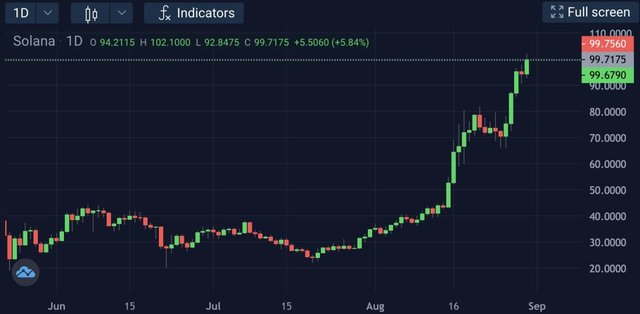
Bill Noble, Token Metrics’ top analyst, believes that Solana can only be stopped if the cryptocurrency market crashes. Otherwise, the coin will soon reach $145.
The StormGain Analytical Group
517
« on: August 30, 2021, 11:58:26 AM »
NFTs are making a comeback as ETH booms
Non-fungible tokens, or NFTs, were the talk of the crypto community, the wider finance community and the art world earlier this year thanks to striking artworks, celebrity participation and eyebrow-raising sales prices. These elicited frantic headlines across the mainstream press that made the general public interested in what had previously been an obscure phenomenon: digital items that can be verified as unique on the blockchain.
The media buzz was driven by the $69-million sale of the digital artwork Everydays: The First 5000 Days by Beeple. It was the spearhead of NFT mania, with big-ticket digital tokens selling for millions of dollars. Meanwhile, an NFT representing the first-ever tweet by Jack Dorsey sold for a comparatively humble $3 million compared to Beeple’s work, whereas blockchain collectables such as rare CryptoPunks sold for over $7 million.
The NFT feeding frenzy subsided during the summer, leading some to say that investors’ interest in NFTs was a one-time event. But the market is proving them wrong. In fact, NFT trading has just hit new heights.
CoinDesk recently reported that the number of sales on OpenSea, the largest NFT marketplace, has surpassed the NFT craze seen in the spring multiple-fold. Daily sales hit over 60,000 tokens in the past week, almost eight times more than March’s all-time high (source: Coin Metrics). Blockchain industry data tracking firm DappRadar also reported that trading volume on OpenSea was $1.22 billion over the last 30 days, a 933% increase over the previous 30-day period.
So, what exactly is being traded? So far, the current surge indicates the continued success of NFT collectables such as CryptoPunk (pixel art headshots with various fashion accessories), Bored Ape Yacht Club (similar to CryptoPunks, but the characters are apes) and Pudgy Penguins (take a guess!). Like limited-edition trading cards, these digital tokens can no longer be bought directly from the producers but are traded to the highest bidder on platforms such as OpenSea.
But even if trade in crypto-collectables is thriving, they don’t garner the same public interest as Beeple or Jack Dorsey’s NFTs. Global Google search activity for NFTs still ranks lower than in March, the height of NFT trending in the mainstream media.
What could this mean for crypto traders?
Even if they don’t touch NFTs themselves, crypto traders should be aware of how the NFT market affects the cryptocurrency economy as a whole. Most NFTs reside on the Ethereum blockchain and are priced in Ether (ETH), the second cryptocurrency by market cap. A boom in the NFT market could drive up interest in ETH and, consequently, the value of the cryptocurrency. This is what appeared to happen in March when OpenSea sales increased alongside the price of ETH. But NFTs are only part of the Ethereum ecosystem. In May, ETH’s price soared even as NFT sales slumped to dismal levels. So, a trader should consider all the aspects surrounding Ethereum, not just NFTs.
At the time of writing, ETH is up by over 65% over the last 30 days, outpacing Bitcoin in gains. This may be explained by the recent London hard fork, which improved efficiency and transaction fees on the Ethereum network when it went live on 5 August. With ETH’s increased attractiveness to investors resulting from the fork combined with high NFT trading volume, we could see a pattern of increased confidence in and demand for Ether.
Trade ETH, BTC and more at the best rates with StormGain
Whether you’re looking to trade ETH on the back of NFT success or investing in any cryptocurrency to increase your wealth, it’s important to have the best tools for the job at your fingertips. StormGain provides exactly that: an all-in-one crypto trading platform with trading signals, analytics and charts built into an easy-to-use app. Trade over 65 different digital assets, including Bitcoin, 50+ altcoins, crypto indices and even tokenised stocks in Apple, Tesla and other tech giants. All this with the best features in the industry, including free Bitcoin rewards, loyalty bonuses for trading, up to 12% interest on your crypto holdings and a generous zero-commission profit-sharing model.
Not a StormGain user? Register now in just a few seconds and try the risk-free demo account to see how much you could make trading cryptocurrency with the best perks in the business!
518
« on: August 27, 2021, 10:55:07 AM »
Metrics: Bitcoin keeps growing despite lacklustre user activity
Bitcoin’s price has risen by 40% to around $50,000 without high speculative activity amidst a background of plunging trading volumes and a low number of transactions. Is this indicative of a looming correction?
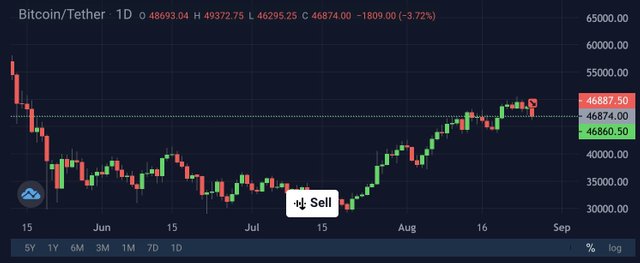
Bitcoin transactions are around five-year lows, which was last observed together with an 85% drop in prices from the highs of 2017.
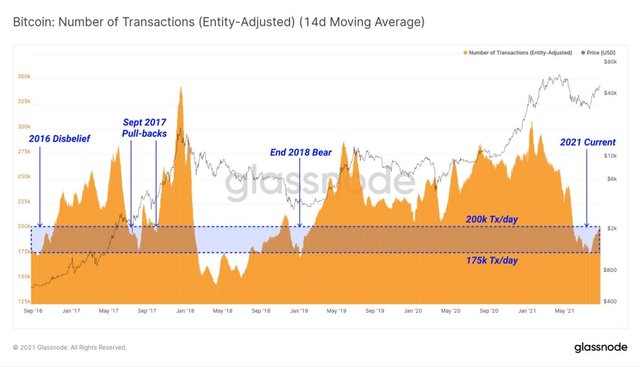
In addition to the lower number of transactions, trading volume has also dropped, which Arcana Research views as a bearish signal. The recent price growth has not correlated with vast interest.
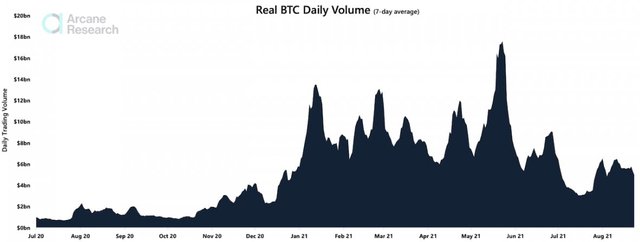
However, several objective reasons can explain this. Firstly, the number of transactions has fallen because of pressure from Chinese regulators. Some exchanges are changing their registration, others are refusing to accept Chinese citizens’ funds, and miners have simply been prohibited from working in some provinces. Secondly, the world’s largest crypto exchange, Binance, has become a subject of public discontent in many countries. Because of regulatory pressure, the exchange has lowered its leverage from 1:100 to 1:20, leading to a slump in trading volume.
Meanwhile, the Fear and Greed indicator is showing that market optimism has gone last. SOPR (Spent Output Profit Ratio) indicates the same thing: most traders are once again making profit from selling their coins
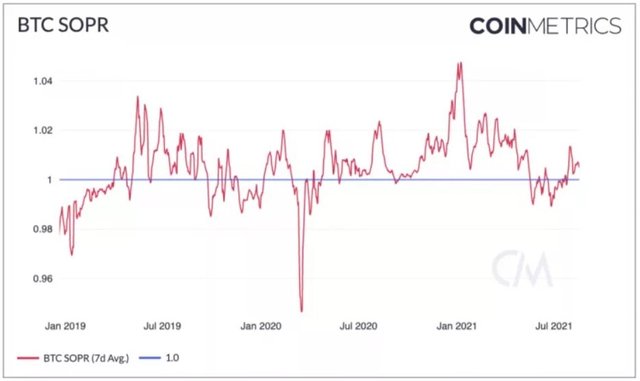
While traders took a break and are not showing much activity, institutional investors continue their hunt for bitcoin. For example, MicroStrategy bought $177 million worth of BTC at an average price of $45,000 per coin and currently owns 108,992 BTC. Citigroup has followed in Goldman Sachs’ footsteps, submitting an application to regulatory bodies for access to Bitcoin futures on the Chicago Mercantile Exchange.
Currently, activity on the network does not indicate an impending correction. The drop in volume is related to regulatory pressure and reduced trading leverage. Meanwhile, holders and institutional investors are continuing to accumulate.
The StormGain Analytical Group
519
« on: August 24, 2021, 08:23:34 AM »
NVIDIA: Mining processors vs video cards
Increased GPU prices have caused a backlash between miners and gamers. AMD has come clean, saying that this conflict is none of its business. However, NVIDIA has tried to split up its GPU product line and produce an ASIC equivalent, with little success.
The third-generation graphic cards released in autumn last year are highly efficient at ethereum mining. Meanwhile, the coin rose from $350 in October to $2,000 in five months, and graphic adapters are becoming hard to find.
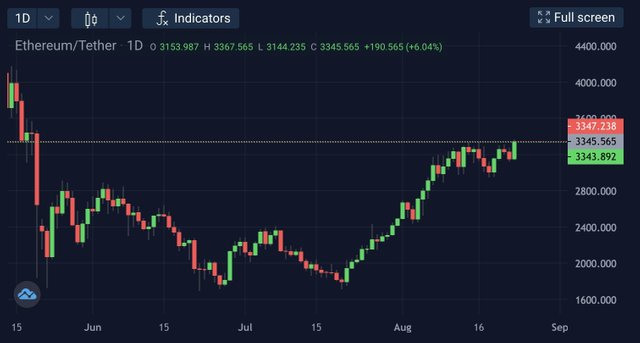
The first decision NVIDIA made was to limit the output of some graphic cards, but miners managed to bypass this obstacle. The second decision was the production of specialised chips for mining. In February, the company announced the launch of its new CMP (crypto-mining processor) series. The 30HX and 40HX models became available for order in Q1 2021.
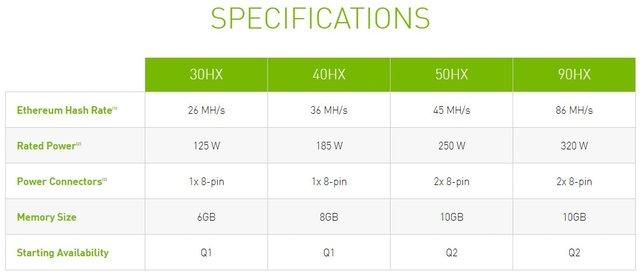
However, the demand for these was not as high as NVIDIA expected. The company planned to earn $400M on CMP sales by the end of Q2, but actual income was $266M. Commenting on the figures, Chief Financial Officer Colette Kress said that the company did not expect substantial revenue contribution from CMP sales in the future.
There are several reasons for this product line's failure. First, even top-end machines are lagging behind the top-of-the-line graphic cards in terms of hashing power. Second, the cost and energy efficiency remain pretty much similar. Therefore, few people are willing to buy highly specialised machines with no video output. Let's take compare the effectiveness and ROI of CMP 30HX vs RTX 3060.
The mining chip produces 26 Mh/s, consuming 125 W. The graphic card can be accelerated to up to 48 Mh/s while consuming 170 W. Energy-wise, it's more profitable, but it costs more: $1,000 vs $750. However, because of the permanent increase in mining difficulty, hashing power is what makes the ultimate difference, and even profitability calculators show that RTX 3060 is almost twice as good as CMP 30.
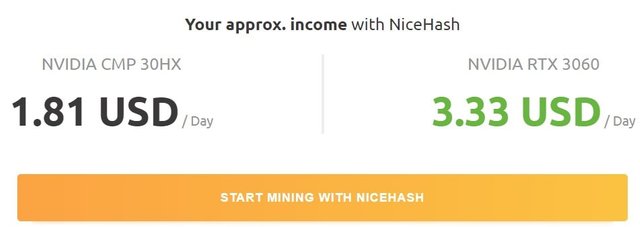
It takes 300 days to reach full ROI on the graphic card, compared to 414 days for the CMP. Because of increased mining difficulty, you will have to unplug 30HX at some point, while RTX 3060 will keep on producing revenue. Another thing is that even if the graphic card is discarded for mining, it can still be used for its intended purpose, but there is no second life for the CMP.
The NVIDIA CPM product line is the same old graphic card, only slightly redesigned and cheaper. However, consumers did not appreciate this approach: as ethereum's price increased, so, too, is the demand for graphic cards.
The StormGain Analytical Group
520
« on: August 23, 2021, 09:43:49 AM »
Hermitage and Rammstein at Odds over NFT
Non-fungible tokens (NFTs) are a new type of crypto asset that has simplified buying and selling, exchanging and working with digital artworks' copyrights. This market continues to grow exponentially despite all the difficulties cryptocurrencies have been facing.
In March, we saw a spike in the interest in NFTs caused by the success of Mike Winkleman's picture, Everydays: The First 5,000 Days. It turned out to be the most expensive JPEG file in history, selling for $69 million at a Christie's auction. There was also a rally on the cryptocurrency market, and Ethereum, the platform for most NFTs, rose from $1,400 to $4,400 in May.
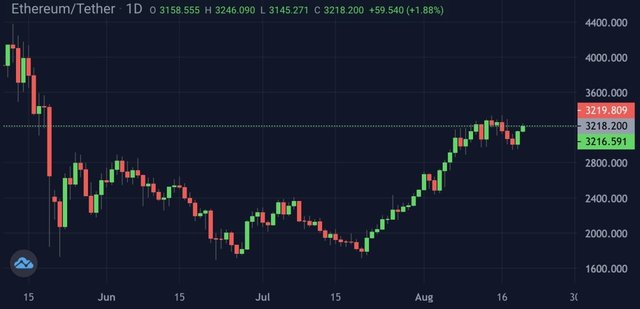
Increasing interest in cryptocurrencies and non-fungible tokens has caused a record growth of network fees on the Ethereum network. Sceptics were prophesying a downfall of the NFT market, but that didn't happen. Now, fundraising is at March levels again, and the daily NFT turnover at OpenSea has grown eight-fold.
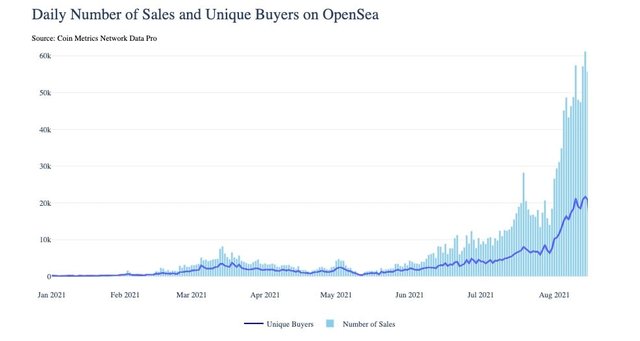
The daily volume has reached 60,000 NFTs, and the trading volume in the last month grew by 933% to hit $1.2 billion. And that is just the data for a single platform. The entire market is now projected to grow from $1 billion to $15 billion next year. The growing interest in NFTs is leading some to monetise their activities, from football clubs to giants like NASA.
Occasionally, unpleasant copyright-related things happen. For example, DC Comics asked artists in March not to use their characters to make NFTs as the company was planning to enter the new market. Furthermore, last week, a scandal broke out between the group Rammstein's lead vocalist and the Hermitage Museum. Till Lindemann recorded a video for the song Lubimiy Gorod (Beloved City) for the museum. However, according to his agreement with the Hermitage, he could only use the recorded materials in the video. The singer nevertheless launched an NFT collection based on the visuals recorded.

Five tokens have been put up for auction, advertised as 'Hermitage Edition'. The most expensive of them has been priced at $100,000, and there are 10 copies. Buyers will also have the opportunity to dine with Lindemann in Moscow.
The Russian state-owned Hermitage has sent a letter of claim to both the Rammstein frontman and NFT Frame Art, the platform that listed the tokens. However, the museum has not disclosed its proposal for resolving the conflict. Currently, nothing is known about any responses.
Like DC Comics, Hermitage also has plans to monetise art objects. In autumn 2021, an exhibition will take place, where the museum will put its own NFTs up for sale. The Hermitage's director, Mikhail Piotrovsky, has said that "NFT is a route that creates democracy, makes luxury more accessible, but at the same time exceptional and exclusive".
Despite the lack of a clear legal framework, the number of NFT proponents is growing. This will make cryptocurrencies more attractive and speed up their integration in the near future.
The StormGain Analytical Group
521
« on: August 18, 2021, 03:24:59 PM »
StormGain debuts new crypto options
StormGain is happy to announce the debut of an exciting new trading instrument on the platform: crypto options! Now, instead of simply being able to trade cryptocurrencies, StormGain users can place Call and Put option orders based on a cryptocurrency’s potential future price. This means you can trade on the price changes of a digital asset without having to actually own or hold the asset itself. Crypto options are perfect if your main interest in cryptocurrency is to profit from price volatility rather than collect digital tokens.
How do crypto options work?
Options, including crypto options, are derivative instruments that trade on the price fluctuations of the underlying asset. They provide traders with the option, but not the requirement, to buy or sell a specified amount of the asset at the price it was trading at when the contract was initiated. Because you’re not required to buy or sell, this opens up a more flexible trading strategy.
There are two types of crypto options you can buy and trade. One of these is Call options, which give you the right to buy the underlying asset at a predetermined price at any time before a specified expiry date. Similarly, Put options give you the right to sell the underlying asset at a predetermined price before the date.
The price of crypto options is called a strike price, which is influenced by the actual price of the underlying asset, the expiry date, the asset’s volatility and demand for the option.
How can crypto options benefit me?
Crypto options are cheaper than buying the coins outright and allow you to benefit from higher volatility, giving you the potential for much higher returns on your investment. For example, even a relatively small movement on the price of Bitcoin will affect the price of the option by much higher multiples. At the same time, should the future price of BTC not go your way, it’s not possible to lose more than your initial investment in buying the strike price.
Options are great for various trading strategies, such as using long calls (for a bullish approach) or puts (when you predict a bear market) to maximise your profits. More cautious investors can even take both kinds of options on the same underlying asset (known as straddling) or hedge by taking a Put option on their holdings, which compensates for an asset’s potential depreciation.
Crypto options open a wealth of more sophisticated trading strategies that let you use your knowledge of the crypto market to make even more profit. For a more detailed breakdown of how to use crypto options, we recommend that you check out this series of educational articles with examples of Call and Put options and hedging strategies.
Where can I find crypto options?
To trade options on any asset, simply open the StormGain app or web platform and open your cryptocurrency of choice. You’ll see an ‘Options’ tab that shows the strike price and expiry date for each one.
With the introduction of crypto options, StormGain offers yet another way to get cryptocurrency to make money for you. That’s in addition to the best rates on a wide variety of cryptocurrency purchases and exchanges, crypto wallets with up to 12% APR interest, indices and tokenised assets. Sign in to StormGain to see what crypto options can do for your trading profit. Not a member? Then register with StormGain in just five seconds to start trading today!
522
« on: August 17, 2021, 12:32:58 PM »
Ethereum will soon abandon mining. Will GPUs get cheaper?
At the World Blockchain Conference in late July, Vitalik Buterin set the beginning of 2022 as the date of a possible transition to a proof-of-stake protocol, when validators will become responsible for processing transactions, and miners will be put out of a job. However, this does not stop either miners or hardware manufacturers.
On 5 August, the London hard fork took place, followed by the Altair update on 19 August. According to the roadmap, these are the last steps before the merger of the two forks, codenamed ‘The Merger’, happens. The difficulty bomb is scheduled for early December but will most likely be rescheduled for Q1 2022.
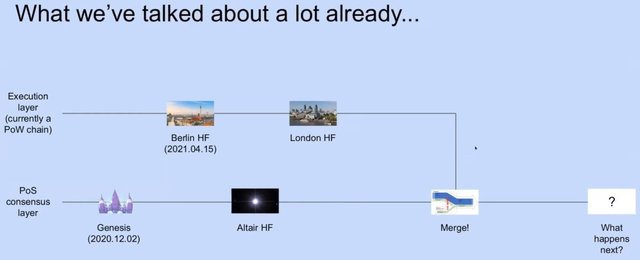
Over 90% of Ethereum mining is done with GPUs. However, in recent years, a breakthrough was made in producing ASICs for the ETHash algorithm. For instance, in early 2021, NVIDIA presented its first chip for ETH mining, which can hash 26 Mh/s at 125 W. The availability of efficient machines attracted institutional investors, for whom the payback period is less in the Ethereum network than in the Bitcoin network. According to the CEO of Luxor mining centre, Ethan Vera, the ROI period on Ethereum mining hardware is four months, but over a year for Bitcoin.
This circumstance has caused mining companies to increase their hash power despite the PoS risks. In October 2020, Hive Blockchain became the biggest public Ethereum miner at 3.4 Gh/s; it plans to ramp up its hashing power to 5.5 Gh/s by the end of 2021. Hut 8 is close behind, having bought $30 million worth of hardware from NVIDIA, which will give it 1.6 Gh/s more hash power this month.
Miners expect that The Merger implementation period will shift: this regularly happens in Vitalik Buterin’s network. So, they don’t want to miss out on the profit they could make on the second-largest cryptocurrency.
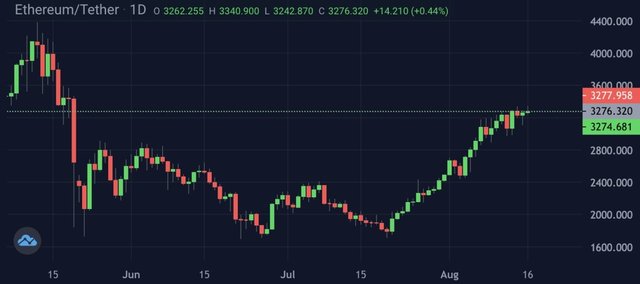
ASIC manufacturers are backing miners in their arms race. Bitmain, Innosilicon and iPollo have already announced the availability of Ethereum ASICs by the end of this year. iPollo has already received pre-orders worth $200 million.
The most frequently asked question among some in the crypto community is ‘when will GPUs get cheaper?’ The risk of proof-of-work being abandoned does not dampen companies’ ardour in their pursuit of hashing power. Gamers’ last hope hangs on the development of ASICs that could push GPUs out of mining. Mining difficulty will grow as long as institutional demand is met, and the GPU mining ROI period will soon surpass one year. If ETH doesn’t reach its all-time high again by that time, miners’ demand for them will substantially decrease.
The StormGain Analytical Group
523
« on: August 13, 2021, 11:10:24 AM »
Bitcoin or Gold: 571,000% or -5.5%?
Bitcoin has proven to be a more profitable investment than gold.
Gold loses to Bitcoin in the 1-year and 10-year ranges.
While some are debating whether investments in bitcoin and gold can be compared, the maths gives a clear answer that doesn't favour the precious metal. The 10-year yield of gold has gone into the red while investments in Bitcoin have reached a mind-boggling 571,000%.

Back in 2017, a troy ounce of gold could get you 1 digital coin. Since then, the price of gold has fallen to be 25 times less than that of Bitcoin. Gold has always been viewed as a hedge against inflation, so it's even more surprising to see it fall to a four-year low four days before the United States releases its inflation report.
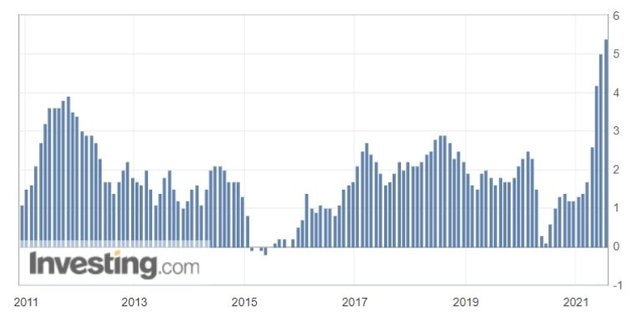
Inflation is at its highest level in the past ten years. The Federal Reserve is starting to curb its bond-buying programme in Q4 and won't hike interest rates before 2023. Peter Schiff, a key proponent of gold, believes that traders are wrong to sell it. The Fed won't be able to cope with inflation in the next few years, and Bitcoin shouldn't be perceived as digital gold.
The comparison of gold to Bitcoin looks dubious: many investment tycoons, such as Jamie Dimon of J.P. Morgan and David Solomon of Goldman Sachs, criticise cryptocurrency while still creating services to invest in and trade it. In early 2021, JPM analysts predicted that Bitcoin would drive out gold as a store of value and assessed its price in the long term at $146,000.
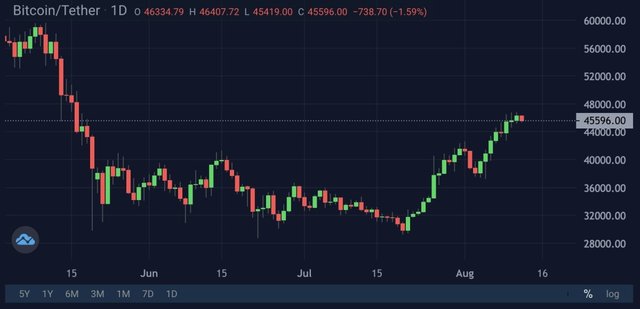
Is Bitcoin really becoming an alternative hedge against inflation instead of gold? Today, the US CPI is being released today: if demand is still above market expectations and Bitcoin keeps growing on this news, the trend will receive another confirmation.
Subscribe to stay up-to-date on great ideas!
The StormGain Analytic Team
524
« on: August 12, 2021, 11:30:43 AM »
$1.5 Billion worth of ethereum to be burned by year’s end
On 5 August, the London hard fork took place and launched a deflationary mechanism for Ethereum. In it, the base payment for processing transactions will now be burned, and miners only get a ‘tip’ for mining a block. Around one-third of the newly mined ETH will be burned.
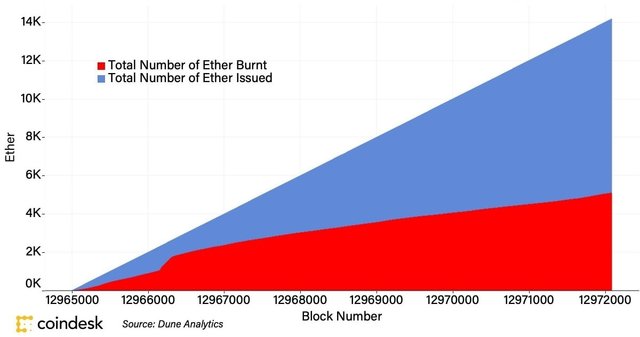
In general, about 2.5 ETH get burned every minute, which, at the current pace and the price of the altcoin, will lead to $1.5 billion worth of the asset being taken out of circulation by the end of the year and 0.4% from its entire capitalisation. This is expected to act as a deflationary mechanism that will lead to an increase in price due to reduced supply. The network’s upgrade has already caused a 13% price spike, although many envision Ethereum reaching $4000 – $5000 by the end of the year.
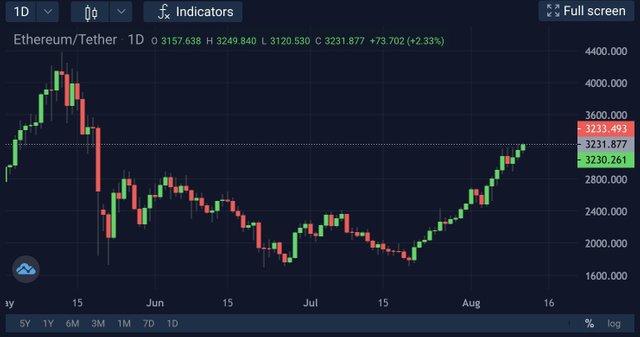
Despite the storm in the Chinese market, investments in the cryptocurrency market are at their peak. For example, in the first half of 2021, world venture capital investment funds constituted $288 billion, 95% higher than in the same period in 2020. The biggest interest is with the projects linked to NFTs and DeFi services, most of which have been built using Ethereum smart contracts. Because of that, the share among all cryptocurrencies has grown from 8% to 20% in six months.

But not everything is working according to plan. Despite the deflationary mechanism, the hard fork was meant to lower the fee size by abandoning the auction model. Despite the relatively small ‘tip’ size, the cumulative fee size has continued to grow.

High fees hinder the attraction of new investments and diminish interest in Ethereum, but everything is expected to change with the coming of Proof-of-Stake, which is expected to launch in December 2021. The new algorithm will end mining, increase operation speed and decrease transaction costs. The nearing transition that many are anticipating, plus the deflationary mechanism, could be a catalyst for Ethereum’s price growth for the rest of the year.
The StormGain Analytical Group
525
« on: August 10, 2021, 04:13:36 PM »
Should you invest in Dogecoin’s copycat?
The popular meme cryptocurrency Dogecoin has increased in price 2,000-fold since it launched. It currently ranks 8th among cryptocurrencies by market capitalisation, coming in at $26 billion. This success was the reason for a wave of copycats, and Elon Musk — called “the Dogefather” by his admirers — played an important role in their surge in popularity.
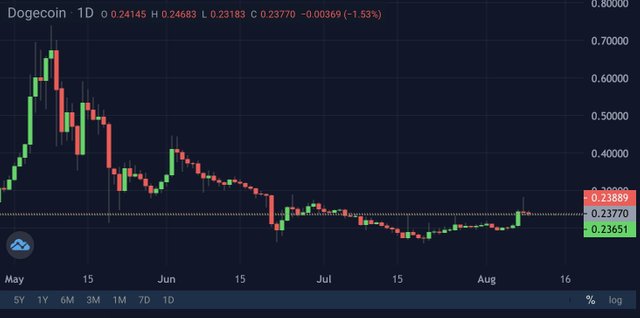
In 2013, Jackson Palmer and Billy Marcus launched Dogecoin as a joke and named it so that no one would take it seriously. But users loved it, and the coin quickly amassed a vibrant community. In 2014, they used Dogecoin to raise funds for charity events, after which the coin became really popular, and its price started a meteoric rise.
More than once, Elon Musk declared his love for the community on Twitter, and the cryptocurrency’s price jumped after every tweet.
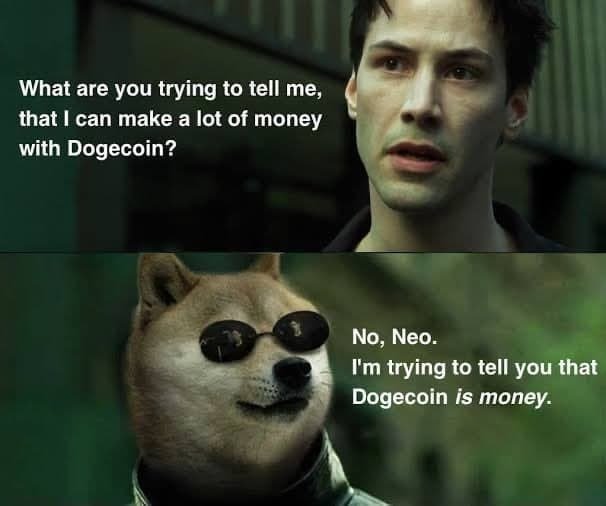
Dogecoin’s success sparked many copycats, with the website news.bitcoin.com finding 30 of them as of 4 August, though there are, in fact, more.
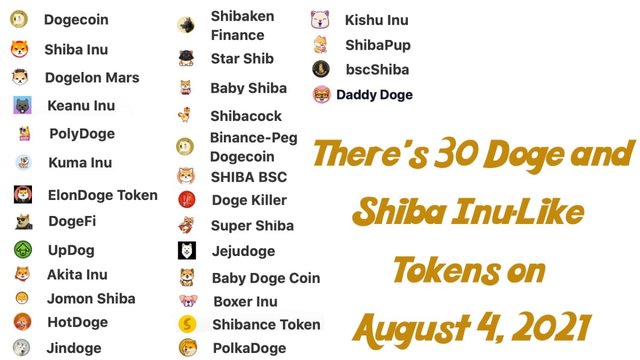
Contrary to Dogecoin, a decentralised coin supported by miners’ operations, the copycats’ issuance is in the hands of individuals primarily chasing material wealth. For some reason, Elon Musk pumps them, too, every now and again, causing serious price movements for these low-liquidity assets. At the beginning of July, he wrote the inscrutable “BabyDoge, doo, doo, doo…”, which was followed by Baby Doge Coin rising threefold. Less than two weeks later, he made a DaddyDoge shout-out for his audience: in one day, that coin’s price rose ten times, and its daily volume increased from $300,000 to $15,000,000.
But not all individuals support the Dogecoin copycats. Searching for acknowledgement, Shiba Inu’s founders gifted half of their issued tokens to Vitalik Buterin, over $7 billion at the time. He sent $1 billion to an Indian anti-COVID fund and simply burnt the rest, asking the community not to bother him with such gifts. Following the news, the token’s price plummeted down.
However, this is typical of such copycats: once a high-visibility person mentions them, their price increase several-dozen-fold but doesn’t stay there. So, if you want to have a laugh along with the others and invest in a meme cryptocurrency, Dogecoin is still the best bet.
The StormGain Analytics Group
Pages: 1 ... 33 34 [35] 36 37 38
ETH & ERC20 Tokens Donations: 0x2143F7146F0AadC0F9d85ea98F23273Da0e002Ab
BNB & BEP20 Tokens Donations:
0xcbDAB774B5659cB905d4db5487F9e2057b96147F
BTC Donations:
bc1qjf99wr3dz9jn9fr43q28x0r50zeyxewcq8swng
BTC Tips for Moderators:
1Pz1S3d4Aiq7QE4m3MmuoUPEvKaAYbZRoG



 Latest news:
Latest news: 





 Shop
Shop
 Bidding Open
Bidding Open